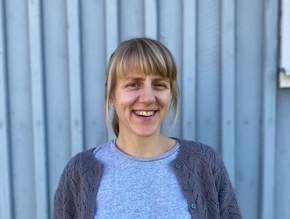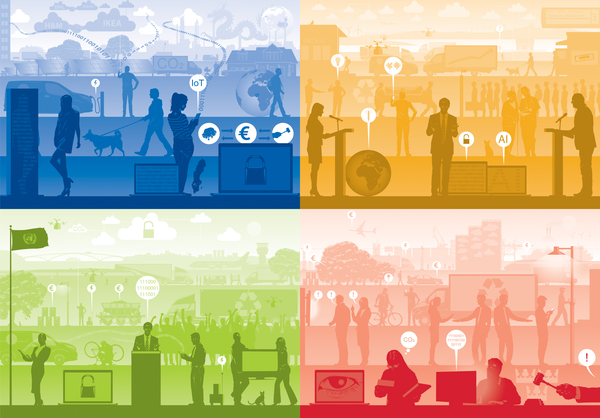How Will Digitalization Change Road Freight Transport?
How will digitalization impact road freight transportation? It provides opportunities to improve efficiency, reduce costs, and increase service levels, but many uncertainties still remains. This paper presents four different futures we soon might find ourselves in.
ITRL director and researcher Anna Pernestål sits down with us to answer our questions regarding this exciting paper:

“How Will Digitalization Change Road Freight Transport? Scenarios Tested in Sweden”
The paper was published in the journal Sustainability and was written by Anna and her colleagues Albin Engholm, Marie Bemler, and Gyözö Gidofalvi.
In order to make ITRL’s research more accessible to both the industry and the public, we asked a range of questions that give an overview of Anna’s paper and inspire you to learn more.
What is the paper about?
Digitalization will have a big impact on freight transport and society. Digitalization will also impact how much we shop online and our demands on online retailers, where we choose to live and so on. Today, a driver spends circa 5% of their time on paperwork, digitalization could reduce this and make supply chains more effective. We investigated how the digitalized freight transport system might look like in the future, but it’s uncertain and we can’t pinpoint how it would look since trends don’t all point in the same direction, therefore we established four different possible scenarios. We have worked with over 50 experts from more than 30 organisations, academic institutions, businesses, and public authorities. First, we identified trends in seen in society today and which of these are more, or less, certain. From these trends we have identified two so called “Strategic uncertainties”. Each of these can have two outcomes, put them together and you get a matrix with four scenarios, then we had the experts explore how freight transport would be affected in them.
Can you give an overview of the results?
The four scenarios are stories of how our future might look like, they’re not necessarily the future we want. We want them to be used as a foundation and input to businesses, authorities and research organisations in their strategies. A result we have seen in all four scenarios is an increase in transportation, which will likely result in increased emissions. In some of the scenarios there is a clear focus on sustainability and even in them the experts expected emissions to rise.
Another interesting reflection, if you think about supply chain you probably think about a material-to-production-to-customer structure, linear transport. But there is also backflows with recycling, products being fixed and sold again, or peer-to-peer freight transport. In these backflows and circular economy transportation will increase in most scenarios as well, you don’t think about that when talking about a circular economy. Those transportation chains are usually more complex to optimize compared to linear supply chains. If we want to optimize the backflows we need more data sharing and digitalization, maybe even new ways to structure operations.

What differs the scenarios from one another?
One of the strategic uncertainties is regarding the level of focus of green sustainability. Is it the number one priority? Or will we simply view it as important but as just one of 17 Sustainable Development Goals?
The other strategic uncertainty is how businesses and industries will organise, today we have a relatively hierarchical and traditional structure. On the other end we also have community based structures inspired by Airbnb and made possible by blockchain technology or a platform economy. If I want to transport something I can post it to a platform and anybody can bid on it.
In a scenario called “Folkhemmet 2.0”, or Social engineering, we have a strong focus on sustainability with the traditional business structure. There is political support for this with policies and high taxes on things that aren’t environment friendly, maybe they have subsidies for those that are sustainable. You don’t share really share data, instead you optimize within your own business structures. At the same time there are external demands on the organisation to meet the sustainability goals, it’s their responsibility to demonstrate it and it requires large corporations to sign strategic agreements.
In another scenario, diagonally across in the matrix, is a network based organisation and sustainability is only one of 17 goals. Here we have a focus on services, if your order something online it arrives before you have even ordered. It’s extremely short delivery times, a lot of data sharing and focus on customer experience, it’s easy to use and socially sustainable. Companies will use data sharing, artificial intelligence, and any other means to get there. IT companies and social media will be important actors in this scenario, and they can use their own data to show that they are reaching the goals
Have there been any surprising results?
One interesting insight came from the 50 experts and when we were working to define the scenarios. We researchers in particular struggled with “Folkhemmet 2.0”, Social Engineering, we felt it was too dictatorial. But when we presented it to the experts many preferred that scenario, as they realised that it contained a clear framework and ways to solve the climate challenges without having to change too much in their business structures.
What do you hope this research will lead to?
To start a platform for discussion. When talking about digitalization and its effect on the transportation system there are many different outcomes, with these four scenarios you get a way to structure them in contrasting stories that are both intuitive and logical. Trends are put in a context and you can use these scenarios when developing strategies, for companies and in research. For example, how will a future with autonomous trucks look like? Just simulate in one of these scenarios.
What should industry be paying attention to in regards to the article?
I want the industry to work with these scenarios, to understand that it is not just one future, and that they’re highly involved in creating the future. It’s us together who create and choose which scenario we’ll end up in.
Read the full paper here . Feel free to contact Anna for more information.

